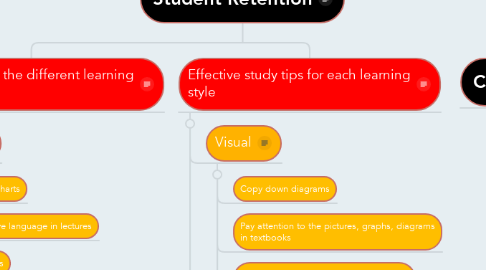
1. Understanding the different learning styles
1.1. Visual
1.1.1. Graphs/Charts
1.1.2. Descriptive language in lectures
1.1.3. Flowcharts
1.1.4. Underlining/Highlighting
1.1.5. Diagrams/Pictures in texbooks
1.1.6. Symbols (@, &)
1.2. Auditory
1.2.1. Discuss topics with others
1.2.2. Record lectures
1.2.3. Examples, stories, jokes
1.3. Read/Write
1.3.1. Lists
1.3.2. Glossaries
1.3.3. Physically taking notes
1.3.4. Textbook reading
1.3.5. Handouts
1.4. Kinesthetic
1.4.1. Use all of the senses
1.4.2. Labs
1.4.3. Real life examples
1.4.4. Field trips
1.4.5. Trial and error
2. Effective study tips for each learning style
2.1. Visual
2.1.1. Copy down diagrams
2.1.2. Pay attention to the pictures, graphs, diagrams in textbooks
2.1.3. Watch videos about the material you are studying
2.1.4. Use different colored pens and highlighters to emphasize different points in notes
2.1.5. Use flash cards to study material
2.1.6. Write using symbols (@, &, *, ~)
2.2. Auditory
2.2.1. Use a audio recorder (on phone, computer etc) to record lectures and discussions (in a campus environment) for review later
2.2.2. Listen to music while studying
2.2.3. If available, listen to an audiobook version of your textbook
2.2.4. Read out loud
2.2.5. Discuss ideas, topics out loud with other people
2.2.6. Talk out loud to yourself about ideas and what you are writing
2.3. Read/Write
2.3.1. Take a lot of detailed (or verbatim) notes
2.3.2. Rewrite notes and/or key points
2.3.3. Create bullet point lists
2.3.4. Write down the glossary terms and definitions
2.3.5. Use handouts, elaborate on them writing your own notes
2.3.6. Write out what diagrams and charts mean in sentences
2.4. Kinesthetic
2.4.1. Study in shorter blocks of time, get up and walk around during breaks
2.4.2. Do something physical while studying; tap a pen, chew gum, squeeze a stress ball
2.4.3. Use real life examples in notes
2.4.4. If possible, go out on a "field trip" to study the subject in real life
2.4.5. When possible, do hands on labs

